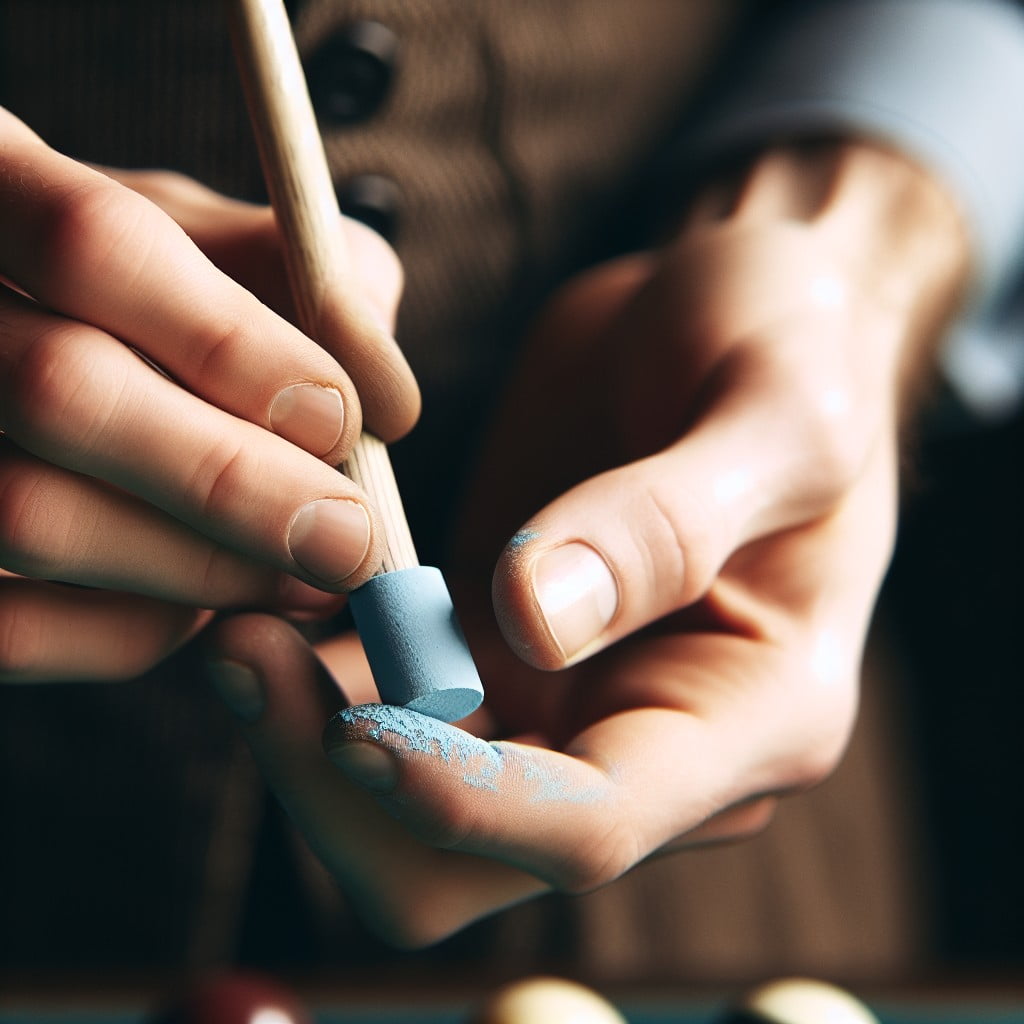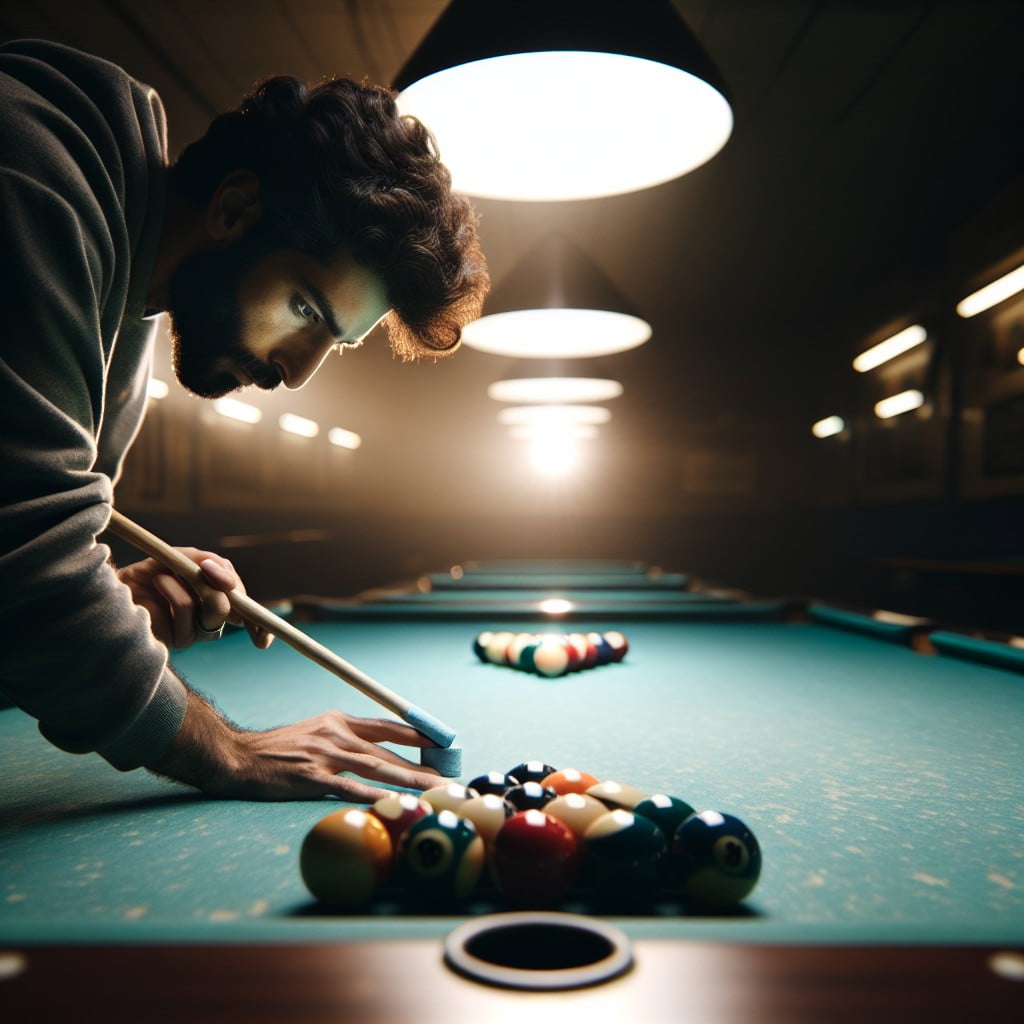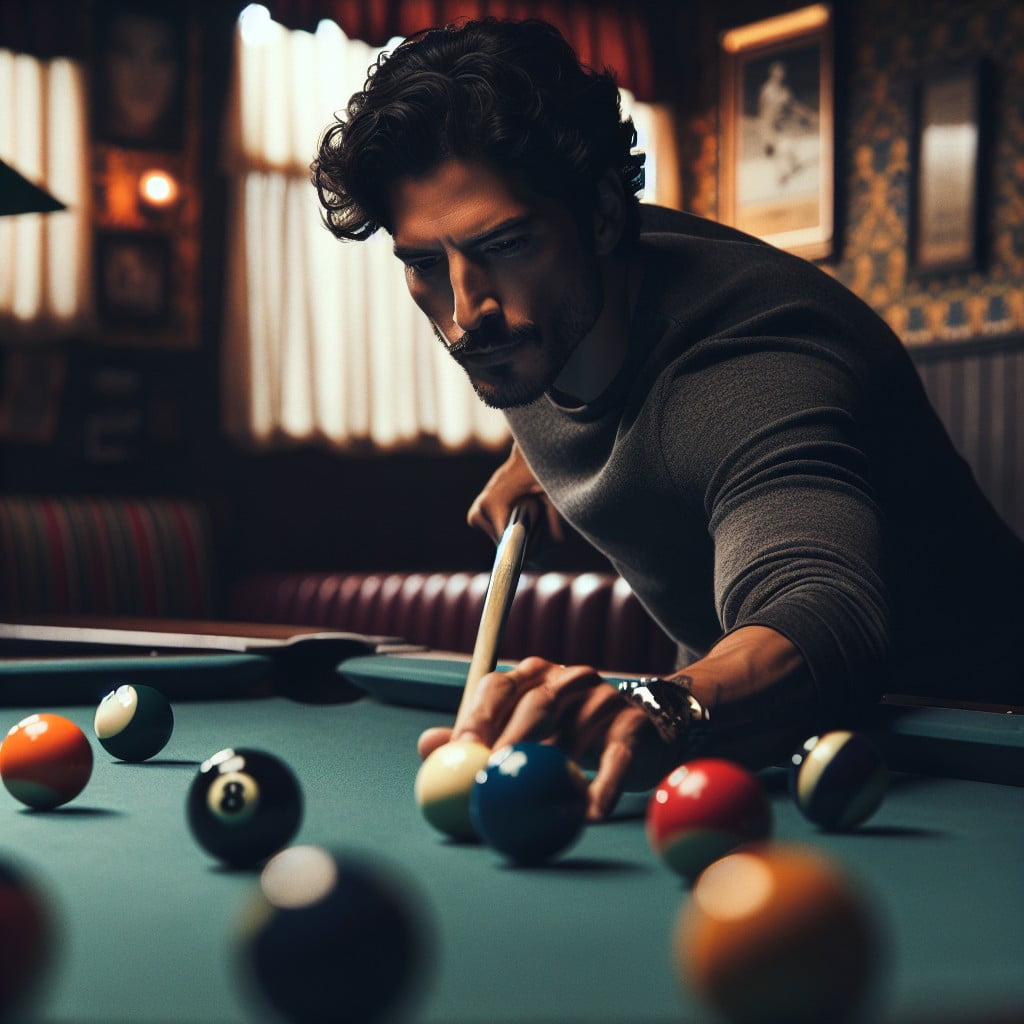Last updated on
Dive into this article to gain a comprehensive understanding of the crucial role that chalk plays in enhancing your pool playing experience, including how it improves your cue’s grip on the ball, and why it’s an indispensable part of the game.
Key takeaways:
- Chalking enhances grip for better ball control and spin.
- Proper chalking prevents miscues and improves consistency.
- Applying chalk with the right technique ensures even coverage.
- Selecting high-quality chalk that matches your skill level is important.
- Chalk before every shot for optimal performance and control.
Why Do You Put Chalk On a Pool Cue?

Applying chalk to the tip of a pool cue enhances friction between the cue tip and the cue ball. This improved grip prevents the cue from sliding off the ball upon impact, especially when striking the ball off-center for various spin effects.
The chalk’s texture is key to ensuring consistent contact, helping to transfer force effectively and accurately without miscuing, a common issue where the tip fails to connect as intended, resulting in a failed shot.
Regular chalking is essential to maintain optimal performance during play.
What Does Pool Chalk Do to Give You Spin?

When you apply chalk to the tip of your pool cue, you enhance its ability to grip the cue ball. This grip is crucial for imparting spin, or ‘English’, on the ball:
1. Friction: Chalk increases the friction between the cue tip and the cue ball, which is necessary when applying side, top, or bottom spin.
2. Control: Chalk allows you to strike the cue ball off-center with precision, a fundamental technique for controlling the spin direction.
3. Consistency: Proper chalking helps maintain consistent performance in your shots, especially when applying various levels of spin.
4. Confidence: Knowing that your cue tip is properly chalked can boost your confidence as you aim for those trickier spins during gameplay.
Remember, mastering spin always comes down to practice; the right amount of chalk is simply one of the tools that can significantly improve your ability to control the cue ball.
How Do You Avoid the Dreaded Miscue?

Avoiding a miscue is crucial to maintaining control during your pool game. Here’s how to ensure a smooth stroke every time:
1. Regular Chalking: Chalk your cue tip before every shot to enhance friction between the cue and the ball.
2. Proper Technique: Strike the cue ball at its center or slightly off-center based on the intended spin, but avoid extreme edges which increase miscue risk.
3. Quality Tips: Use a well-maintained, properly shaped cue tip. A rounded tip with a dime or nickel radius provides a larger surface area for contact and reduces miscue chances.
4. Consistent Stroke: Develop a smooth, steady cue action. Jerky or unstable strokes lead to uneven tip-to-ball contact, raising your miscue odds.
5. Focused Aim: Be precise with your aim. A slight error in angle or direction can result in a miscue, especially if you’re applying spin (English) to the cue ball.
How to Use Pool Chalk Properly

Achieving the perfect cue tip grip with chalk involves a technique that ensures even coverage without overdoing it. Here are some expert pointers:
- 1. Pick up the cube of chalk and hold your cue stick in the other hand.
- 2. Rotate the cue stick, not the chalk, and lightly brush the surface of the chalk across the cue tip. Imagine you’re painting, using just enough pressure to leave a thin layer.
- 3. Cover the entire surface area of the cue tip, but be careful not to dig the chalk deep into the leather, which can lead to an uneven surface.
- 4. Sidestep the common mistake of twisting the chalk on the tip, as this can create too much chalk dust and cause buildup.
- 5. Aim for a matte finish on the cue tip; a glossy sheen indicates excessive chalking.
By adhering to these steps, the cue tip will maintain optimal friction, improving precision on your next shot. Remember, frequent light applications are far more effective than a single heavy coat.
Using Pool Chalk to Achieve the Perfect Cue Tip Grip
Achieving the ideal grip between the cue tip and the pool ball hinges on the friction provided by the chalk. When applied correctly, it creates a thin, even layer that increases the tip’s traction, allowing for precise control and spin without slipping.
Here are some key points to keep in mind:
- Consistent Coverage: Ensure that the entire surface of the cue tip is covered. Thin spots can lead to uneven contact and reduce your control over the cue ball.
- Light Pressure: Apply the chalk with light, consistent strokes to avoid compacting it, which might cause it to flake off more easily during play.
- Regular Reapplication: Reapply chalk before each shot, or at the very least when you’re attempting shots that require extra spin or finesse.
- Mind the Mess: Avoid over-chalking, which can leave residue on the cue ball, potentially affecting its trajectory or leading to unwanted marks on the table.
By following these guidelines, you enhance the probability of a successful shot and reduce the chance of miscues.
Step 1: Pick Your Pool Chalk Wisely
Selecting the right pool chalk is paramount as it can influence your game.
1. Composition: High-quality chalk contains finer particles, providing a smooth application and a better grip on the cue ball. This can enhance spin and control.
2. Consistency: Opt for a chalk that maintains its consistency over time. Some brands may crumble or dry out quickly, requiring frequent replacement.
3. Brand Reputation: Research and choose brands with positive reviews from experienced players. Trusted brands commonly used in tournaments are a safe bet.
4. Match with skill level: Beginners may not need the highest-end chalk, while seasoned players might benefit from premium options that allow for more precise cue ball manipulation.
5. Price vs. Performance: More expensive chalk does not always mean better performance. Consider if the price aligns with the level of improvement it offers in your game.
By taking the time to evaluate your choices based on these points, you can ensure you have chalk that complements your style of play and aids in elevating your performance at the table.
Step 2: The Right Amount of Chalk
Applying too little chalk can lead to miscues and insufficient ball control, while over-chalking might cause a build-up on the cue tip, leading to unpredictable shots. Therefore, the goal is to achieve a thin, even coating across the entire surface of the cue tip.
Imagine gently pressing the chalk onto the tip and giving it a slight twist. This motion ensures coverage without grinding the chalk deep into the leather which can cause an uneven surface. The key here is moderation; you don’t need a thick layer, just enough to see a consistent blue hue over the tip with no bare spots.
Remember, chalk dust should not be freely falling off the cue tip. If that’s happening, you’ve likely overdone it. A good rule of thumb is to chalk before every shot, but with such a light touch that the integrity of the tip is preserved. This practice will maintain optimum friction between your cue and the ball for a precise, controlled strike.
Step 3: Chalking Technique
Hold the chalk cube gently and move the cue tip across it with a slight twisting motion, ensuring an even coating without over-grinding the surface. Light, consistent swipes are preferable—pressing too hard can damage the cue tip and create a smooth, polished surface that reduces friction.
Rotate the cue during the process so that every part of the leather tip comes into contact with the chalk. The aim is to maintain a matte finish that holds the chalk, without caking it. Remember, it’s less about the quantity of chalk applied and more about achieving a uniform coverage that will prevent miscues.
Step 4: Checking Your Work
After applying the chalk, inspect the cue tip to ensure an even coating without any missed spots or excess buildup. It’s important to look for a matte-like finish rather than a glossy appearance, which indicates a well-chalked tip.
Pay attention to the edges; coverage here is crucial as many shots are made with partial cue tip contact. Failing to chalk the edges may result in miscues, particularly on shots requiring side spin. If you find any bare areas, lightly touch them up. However, avoid over-chalking as this can lead to clumps forming on the cue tip and felt, which impacts shot accuracy and table cleanliness.
Step 5: Practice Makes Perfect
Mastering the use of pool chalk takes consistent effort. Regularly applying chalk to your cue tip before each shot may feel mundane, but it’s vital in developing a steady hand and an effective chalking routine.
Here are some tips to refine your practice:
- Integrate chalking into your shooting rhythm to build muscle memory, ensuring that chalking becomes second nature during gameplay.
- Observe the results of your chalking by paying attention to the quality of your spins and shots, adjusting your technique as needed.
- Experiment with different amounts and angles of application to discover the optimal way to maintain the grip between the cue tip and the ball.
- Challenge yourself with various shots that typically require more spin, such as sharp cuts or draws, to test the effectiveness of your chalking method.
- Set aside time in your practice sessions specifically for cue maintenance, including chalking, to emphasize its importance in your overall skill set.
By dedicating time to these practices, your chalking technique will improve, enhancing your control and consistency with each strike.
How Often Should I Chalk My Cue?
Chalking frequency largely depends on personal preference and playing style, but a general rule of thumb is to apply chalk before every shot. This ensures a consistent amount of friction between the cue tip and the ball. Professionals often chalk up after every shot to maintain optimal control and precision.
For casual players, chalking every few shots might suffice, yet always pay attention to how the cue feels during contact. If you notice a decrease in precision or an increase in miscues, it’s likely time to reapply. Listen to the sound and feel of the cue; a chalk-starved tip often leads to a harder, less gripping contact sound.
Remember, too much chalk can cause unwanted build-up on both the cue tip and the cue ball, so aim for a light, even coating.
Does the Color of the Pool Chalk Matter?
The color of pool chalk is largely a matter of personal preference and aesthetics rather than performance. Here are some points to understand when considering chalk color:
1. Match with Felt: Some players choose chalk that matches the color of the pool table felt to minimize the visibility of chalk residue, which can be helpful for maintaining a clean-looking table.
2. Contrast for Visibility: Conversely, using a contrasting chalk color can make it easier to see the amount and location of chalk on the cue tip, aiding in consistent application.
3. No Effect on Grip: The pigment used to color the chalk does not affect its texture or its ability to increase the cue tip’s grip on the cue ball.
4. Mental Game: Some players might have a favorite color that boosts their confidence or focus, which can be a small but personal advantage.
5. Tournaments and Leagues: In certain competitive scenarios, regulations might stipulate the use of a particular chalk color to keep playing conditions uniform for all participants.
Ultimately, while the choice of chalk color won’t change the physical properties of the chalk, it can have subtle impacts on the game experience and player preference.
Can I Use Regular Chalk Instead of Pool Chalk?
While it might be tempting to substitute pool chalk with the type of chalk used in classrooms, doing so would be a mistake. Regular chalk is made primarily for writing on chalkboards, and it lacks the granularity required for proper adhesion to a cue tip. Pool chalk, on the other hand, is composed of a finer abrasive material, specifically designed to increase friction between the cue tip and the cue ball.
Using regular chalk can lead to more frequent miscues, as it does not provide the necessary grip, resulting in a loss of control and precision in your shots. Moreover, classroom chalk could potentially damage the cue tips over time due to its inappropriate texture and hardness.
Stick to pool-specific chalk to ensure that both your equipment and game remain in top shape.
Do You Need a Pool Chalk Holder?
Investing in a pool chalk holder isn’t mandatory, but it’s a convenient accessory for several reasons. It keeps your chalk readily accessible during a game, clipped to your pocket or attached to a keychain. This prevents you from having to search for chalk when it’s your turn to shoot.
Moreover, a holder shields the chalk, reducing the mess of blue dust in your pool cue case and around the playing area. Certain holders even have a cord that secures the chalk to a table or stand, preventing loss. While it’s ultimately a matter of personal preference, a holder can be a practical addition to any pool player’s toolkit.
FAQ
How often should you use chalk in pool?
The frequency of using chalk in pool varies; however, players commonly re-chalk after every other shot or before each shot, particularly when a shot necessitates spin.
Can you play pool without chalk?
While it is technically possible to play pool without chalk, doing so can limit the effectiveness of the shots and negatively affect the overall gameplay.
Can you over chalk a pool cue?
Yes, over-chalking a pool cue can cause a mess on the balls and table, affecting the way the balls roll and react.
Why is pool chalk always blue?
Pool chalk is predominantly blue because it has a longstanding reputation for being of higher quality compared to other colors.
What is the significance of chalking a pool cue after every shot?
Chalking a pool cue after every shot provides the cue with the necessary friction to properly hit and control the ball, preventing slips or miscues.
Does the color of the pool chalk affect the game?
No, the color of the pool chalk does not affect the game as it is primarily used to increase the friction between the cue tip and the ball striking surface.
Can incorrect usage of pool chalk potentially damage the cue?
Yes, incorrect usage of pool chalk can potentially damage the cue.
Recap:




